
What do you do for the rest of the year….?
….and why wouldn’t you think that, with social media and news reports covering the start, middle and finish of harvest in full technicolour video and photos. It is without a doubt the most hectic time of the year, dependent on prayers to the weather gods, testing, hour-by- hour decision making, compromise, more testing, weighing, shovelling, tipping, recording, crushing, pressing, pumping… in fact, all the “-ings” apart from the ones that follow “relax” or “sleep”.
So, I’m here to explain what happens AFTER that period that can (and does) stretch from early January to May.
Now, think of winemaking not only as a process that involves harvesting grapes and converting their juice into wine by fermentation carried out by yeast….. and picture a comet! The head of the comet, apart from scaring impressionable sauropods, is representative of the concentrated burst of time and energy expended in carrying out the initial processes described above. The tail of the comet is then representative of the spread of multiple tasks and time it then takes to meld or nurture that wine to its destination of a packaged and dressed bottle and ultimately making its way to your glass. So what’s involved?
Once the young wine is produced, we must make sure that the inherent quality that we have worked so hard for to achieve, is maintained. This means that we must keep it separate from any process (biological or biochemical) that would undo all the good work. A lot of this involves keeping the wine off “ullage” or not having a full storage vessel of the wine. It’s a problem for boutique and larger wineries alike, and you have to think like a grandmaster chess player to eventually match volumes of wine with tank size so that the desired outcome is that the wine is not exposed to gross amounts of air that can send a wine….errr… off. This can mean necessary transfers from vessel to vessel, as you rack, filter or clean a tank, and combine parcels of wine to fill the empty tank. This is fairly complicated because you have a winery of stainless tanks and oak barrels full of newly made wine (and quite possibly last year’s wine as well), with only a handful of empty vessels to play with. AAAARRRGHH! It’s no wonder we can’t sleep at night! We don’t count sheep, we dream of literages a ’la Queens Gambit.
Of course, you eventually figure it out, but it’s not a job you can do in a couple of days. It can take weeks (or months) of setting up pumps, cleaning and preparing tanks with inert gas cover to exclude oxygen, carefully transferring the wine, then do it again, and again, ad nauseum, until you feel like you’re caught in a liquid version of Tetris. After lab analysis, the What do you do for the rest of the year….?
wine is then put securely to bed, newly filtered or perhaps sitting on lees until it is called for bottling preparation. We have been in the fortunate position of having our wine sell out quickly, which means some our fresher styles are bottled quickly after fermentation, which involves “stabilising” the wine so that it doesn’t throw a deposit or haze. This firstly involves tasting and blending the wine(s) by measuring trial 100 mL aliquots of these, deciding which is the blend that will best satisfy our customers, then transcribing the percentages used to the volume size of the blend…. (100mLs makes the blending maths easier). We then tank- assemble the blend and, in the case of white wines, chill them down to -4 deg C (which is the temperature most home fridges are set at) so that the wine doesn’t throw tartrate in the bottle in the refrigerator door shelf but in the tank. During this time, the wine undergoes basic wine analyses; bottles, caps and boxes are ordered, and the wine is then filtered and sent off to our preferred bottling line, a period that takes about 8 weeks from go to woah! You also have to book time on the bottling line, sometimes months in advance, sort out the labels so that all the legal and mandatory info is correct, check for typo’s…..(I once mistakenly referred to myself as a “Winermaker” on a back label, and you’d be surprised how many times a grape variety has been misspelt !) ….but I digress. These sticky bits of paper are incredibly important in representing your brand to the possible purchasers of your wine, and they must be correct and delivered on-time to the bottling line along with all the other consumables. Did I mention we have to order our barrels now to get them here in time for vintage? A gamble taken hoping we have wine good enough to fill them with.
So, we are generally now into August. In the vineyard, pruning of the vines has taken place, as well as slashing and mowing to keep it all looking neat and tidy. Broken posts or stakes are being replaced, as well as any snapped trellis wire….but what’s that green tinge happening in the white grape blocks? It’s budburst, reminding us that it’s all going to start again in 16 weeks’ time.
We’d better have that production meeting and see what we require in terms of fruit for the coming year. After consensus is reached and the crystal ball consulted, it’s time to contact our growers and work out how much we can expect or want in terms of tonnages of grapes and what they can provide. Back in the winery, the rush is on to clear the tanks and start bottling in earnest. A time that strikes fear into the company’s accountancy team. The bottling pressure slowly builds, as red wines from last year are transferred from their secure barrel reverie and blended (or not) into the tanks you hope you have cleared so that you have room to prepare the wines for bottling. It’s a race against time to clear the decks, a time of slowly hurrying… Barrels are washed and steamed out and younger wine is transferred back into them, hoping that maturation will provide us with the desired result. More testing, tasting (and strong, black coffee), more just -in-time logistics, and getting the wine to bottle and….Phew! That takes care of the spring months.
December, sweet December, when maintenance is foremost in our minds. Making sure everything works and, if it doesn’t, get it fixed. Are we taking a holiday? Maybe a week or What do you do for the rest of the year….?
two to clear the head and watch the southerly busters or La Nina set the vineyard awash just weeks out from harvest.













Leave a comment
This site is protected by hCaptcha and the hCaptcha Privacy Policy and Terms of Service apply.